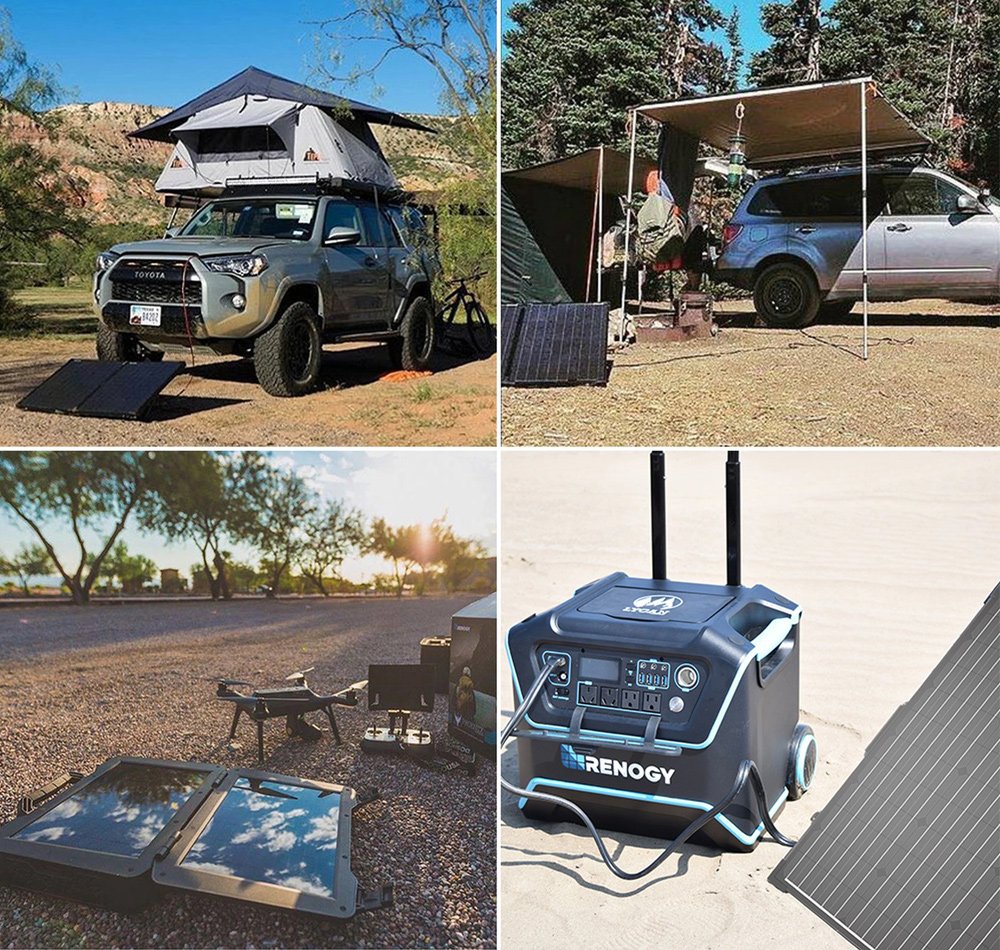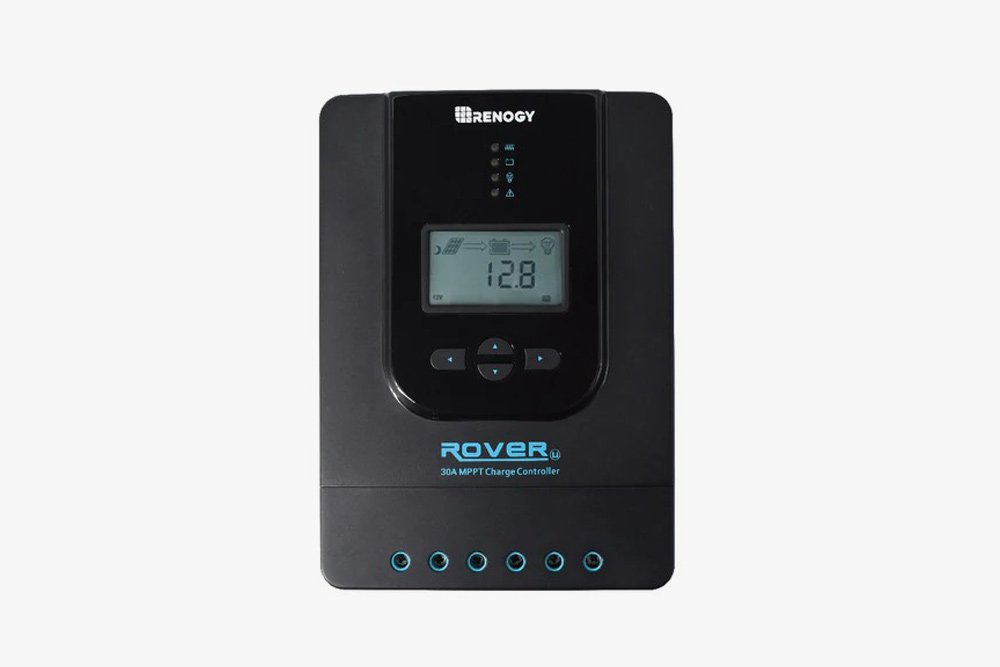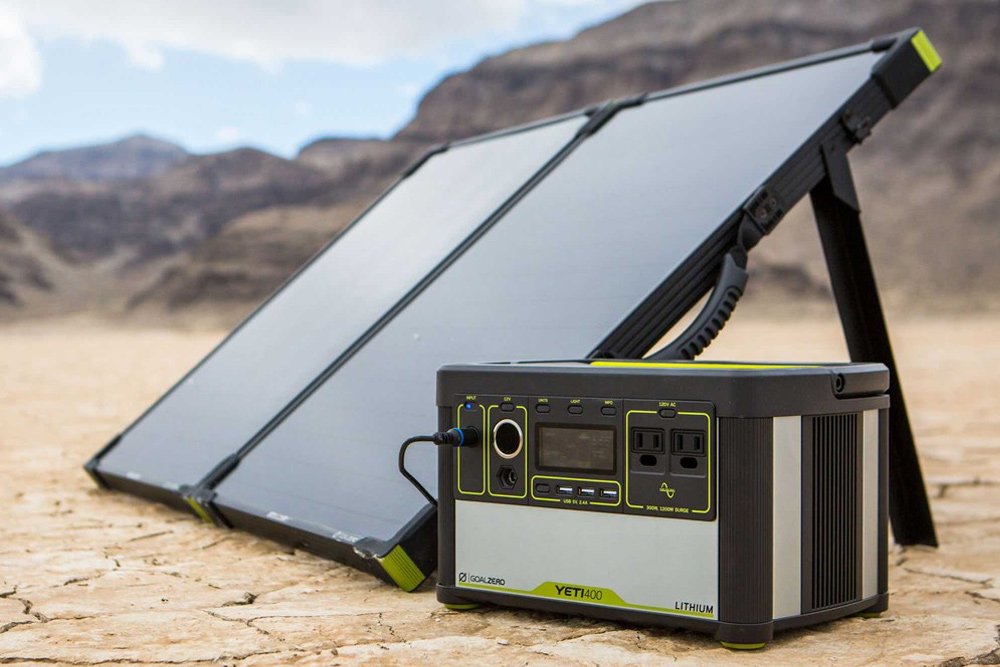
Types of Solar Solutions For Campers & Overlanders: Adding Solar Panels, Solar Generators, Charge Controllers & Batteries
I’ve been using a dual battery/solar setup on my vehicles for at least the last 6 years. While most of my setups also took advantage of charging via the alternator while driving, when camped, the solar panels help keep everything charged up and working.
There are 3 main types of solar panels and plenty of installation possibilities, such as a dual battery setup with solar, a stand-alone battery, charge controller and solar panel, or even a solar panel charging a portable power unit.
What’s best for you? What are the main components?
Well, regardless of what you are planning to run, you’ll need a solar panel, charge controller, and a battery to store the power created from your panel.
Let’s dig a little deeper into these items.
Truck Camping Solar Power Overview
Renogy Solar Panel

Types of Solar Panels
Solar panels can be divided up into three types:
- Monocrystalline
- Polycrystalline
- Thin-Film
While more expensive, monocrystalline offer the highest efficiency and performance. Polycrystalline is a cheaper option but they also have a lower efficiency/performance. Thin-film solar panels offer the advantage of portability and flexibility but this comes at a cost. The thin-film option offers the lowest efficiency/performance out of the three types of panels you can get.
Both monocrystalline and polycrystalline solar panels have cells made of silicon wafers. These wafers are assembled into rows and columns to form a rectangle, then covered with a glass sheet and framed together. But from this point, the solar panels can differ.
While the more efficient monocrystalline are cut from a single, pure crystal of silicon, polycrystalline panels are composed of fragments of silicon crystals that are melted together in a mold before being cut into wafers.
Thin-film solar panels are created from a variety of materials. While the most prevalent is cadmium telluride, they can also be built with amorphous silicon or copper indium gallium selenide.
Renogy Flexible Solar Panel

While it’s easy to recognize a thin-film solar panel, the other two types might be harder to differentiate. A monocrystalline panel typically has black cells while a polycrystalline panel has a bluish hue to the cells.
While it comes down to your application, here’s the rundown:
- Monocrystalline panels can reach efficiencies higher than 20%
- Polycrystalline have efficiencies of between 15-17%
- Thin-film typically only reach about 11% efficiency
So, savings upfront can be costly over the longterm as solar panels tend to have a 25-year lifespan.
Renogy Suitcase Solar Panel & Power Generator

Another option to consider, if you don’t want to mount a panel to your vehicle and if you have limited storage, is a folding suitcase solar panel. These can be packed safely for travel and set up quickly at basecamp.
Find them online:
- 100w Monocrystalline Solar Panel: Check Price
- 100w Polycrystalline Solar Panel: Check Price
- 50w Flexible Solar Panel: Check Price
- 50w Solar Suitcase Panel: Check Price
Charge Controllers

Charge Controllers
Charge controllers are primarily responsible for two things.
- To optimize the charging of your deep cycle batteries
- To prevent electricity stored in the batteries from going through the solar panels when there is no sun
There are two types of charge controllers:
- MPPT (Maximum Power Point Tracking)
- PWM (Pulse Width Modulated)
While more expensive, MPPT controllers can detect the optimum operating voltage and amperage of a solar panel and match it with the battery bank. The result can be an additional 15-30% more power from your panel.
That said, PWM charge controllers are robust, inexpensive and widely used throughout solar installations. However, the nominal voltage of the solar array has to match the voltage of the battery bank, ie: a 12v panel must be used with a 12v battery.
Your application will help dictate which type to select.
My trailer has a 12v deep cell battery and a 100w 12v solar panel. A PWM, in the form of a Morningstar Sunsaver, works just fine for my needs.
CTEK Dual Battery/Solar Configuration

Recently, a number of DC/DC battery charger units have added a solar input option.
In my 4Runner, the heart of my dual battery setup is the CTEK D250SA. It’s a 20a DC/DC charger with a built-in MPPT solar controller. The Australian company, REDARC, also makes a line of DC/DC chargers that also incorporate MPPT solar controllers.
While not inexpensive, these types of units make a lot of sense as part of a dual battery/solar setup. I recently put together an entire write-up that you can find on the site on my dual battery setup.
Find them online:
- REDARC DC/DC Charger: Check Price
- CTEK D250SA DC/DC Charger: Check Price
- Morningstar PWM Controller: Check Price
- Morningstar Sunsaver MPPT Controller: Check Price
- Renogy Rover MPPT Charge Controller: Check Price
Batteries

Batteries & Power Storage Banks
For a solar setup, there are a variety of battery options, but the main two are AGM Deep Cycle and Lithium batteries.
AGM is cheaper and will need to be replaced more often than a lithium battery. While the upfront costs on Lithium LiFeP04 batteries are much higher – they will last much longer. That said, by limiting how deep you discharge your AGM battery, you can extend its life from a typical 5 year to 6-8 years.
Basically, the less your deep cycle battery discharges before recharge, the longer it will last.
While the Optima Yellow Top seems to be the Holy Grail of AGM batteries, there are plenty of other brand choices of deep cell batteries to choose from.
Like everything else, it all comes down to your budget. One further consideration is that it is highly recommended to purchase LiFeP04 batteries that include a battery management system. Most have this built-in but just double-check before making this expensive purchase.
Goal Zero YETI 400 Power Station

Another power option is a dedicated unit from companies such as Goal Zero, Renogy, or Lion Energy.
The Goal Zero YETI line uses a lithium battery and offers both 12v and 110v power options along with USB ports for charging your items. These units can be hooked up to solar panels for charging, but the downside is the time it takes to recharge.
Depending on the size of the solar panel used, it can take 10-20 hours to get back to a full charge. You do have the option of 110v and 12v charging, so technically, you could plug a unit like this into your cigarette lighter while traveling to help top it up. But if you’re just using a solar system to recharge phones, tablets, camera batteries, etc., this could be a perfect option.
These types of units also save adding an inverter to your setup if you need to charge 110v equipment.
Renogy Phoenix 300 Power Station

Find them online:
- Optima Yellow Top AGM battery: Check Price
- LiFeP04 Battery: Check Price
- Goal Zero YETI 400: Check Price
- Lion Energy Safari LT: Check Price
Tips For Cleaning Solar Panels
In many off-road applications, solar panels will get covered with dirt, dust, bird droppings, etc.
Cleaning will become a necessity. However, it is important to avoid scratching the glass surface, which will reduce the solar panel’s output.
Ideally, dish soap and warm water applied with a sponge works best. Oily stains can be removed with a small bit of isopropyl and a rag. Do not use strong cleaning fluids on a solar panel.

Here is a setup you should add Dometic battery PLB40 battery and Overland Solar Bugout 130W solar blanket (https://www.overlandsolar.com/products/bugout-130-solar-charger?variant=31353745899583).
Why?
1) Dometic is Lithium Iron, not Lithium Ion. Double the number of cycles among other benefits.
2) Bugout rolls up and stores much more easily (and is lighter) than the solar panels you reference. It also has extremely high-efficiency panels so charges even in low light. (The company also supplies US special forces, so their stuff is designed to stand up to use.)
3) Dometic has a charge controller built in, so you just need two items – battery and blanket. Need solar? Unroll the blanket, plug it in, done. No need to worry about buying a charge controller, connectors, etc. Simple and reliable.
for this product – with the controller bundle – is that all I would need to simply charge a deep cell? I am going to have a single battery setup in my GX and I’m still trying to figure out what components I will and won’t need for solar (and am getting solar primarily because of adding a fridge).
I’m not sure what you mean by “deep cell” … I have the Dometic PLB40 Lithium Iron battery. I put it in the back of my 4Runner when out exploring primarily to power a fridge when not driving but also to re-charge random electronics (phone, radio, etc.).
I power the battery 2 ways. (1) When driving – it’s plugged into the 12v in the back and (2) by plugging the solar blanket in the the battery when I’m in a spot where I wont move for a few days. All you need is the blanket and the battery, since the battery has a charge controller.
The vehicle battery is not involved – I have nothing hooked up to it.
what I mean is we are not going to have a dual battery setup. Only one battery (a deep cell) in our vehicle. But I will occasionally want to have it charge from solar. I called this company and they answered my question. Sounds like it will fit the bill!
That’s a very cool item and a worthwhile consideration for camping.